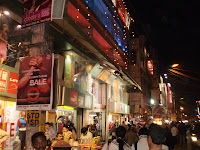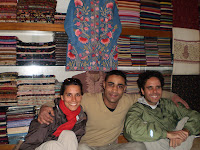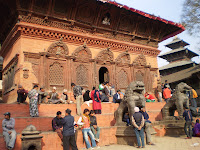We landed at the airport in New Delhi, which was remarkably modern compared to others parts of the country we had seen.


We made our way to the taxi stand and after we felt somewhat confident that our driver might actually know where to go, we jumped into the car. As you might imagine, he basically had no clue where he was going. Fortunately, Sharon spotted the street name and after a couple of 3-point turns, we found ourselves in the lobby of the hotel.
Since we didn't have much time to waste, we headed for the elevated metro and went a few stops to the downtown area in an attempt to book our Delhi city tour and a private tour of the Taj Mahal. Wouldn't you know it - all the information found in our guidebook and online was outdated! But being resourceful, we managed to take care of business and find a wonderful travel agency, book our tours, and find a vegetarian thali restaurant right near our hotel.
Delhi is an enormous city. We spent just as much time in traffic as we did sightseeing. Our first stop on the city tour was Lakshmi Narayan Temple, a Hindi place of prayer that was architecturally beautiful.

Next, we hit the Lotus temple of Bahai. The grounds surrounding the main building were nicely manicured, but the building itself was in the shape of a lotus flower. Inside were rows of seats like you'd find in a temple or church. We were asked to take off our shoes and wait in line to enter. Once inside, we realized nothing was going on, and headed back out.

The Indira Ghandi Museum showcased letters and photographs of this assassinated former prime minister, which was interesting.
As all tours do, we ended up at a tourist trap (AKA shopping center) where we were herded like cattle inside for a display of "authentic" Indian handicrafts. We already knew the drill, so we stood outside instead. While we waited for our group, we noticed a local man pull out a cigarette and toss the empty package on the ground. Sharon kindly informed him that there was a trash bin no more than 5 feet from where he was standing. The man seemed embarrassed, thanked Sharon, and went to pick up his trash and deposit it in the appropriate place. Sharon proceeded to remind him that "it's your country," hoping that the one-person-at-a-time motto will catch on. Our guess is that they don't have the "Woodsy the Owl" public service campaign on Indian television.
The next day, our driver picked us up at approximately 5am for the four-hour drive to Agra. Even though it was 100 and something miles away, with all the traffic, it takes a long time to get there. Our first stop was Akbar's tomb. It was a beautiful building, but we chose to take a quick snapshot and continue to our main destination, as time was short.
On the way from Akbar's tomb we picked up our guide, Ram. When we reached the gate to purchase our admission tickets, our guide walked up to the window with us and somehow managed to get Marc in for free by showing his white cane. After going through the metal detector, we were inside the grounds and Ram told us the history of this memorial shrine.
When you first enter the grounds, you are not yet faced with the famous Taj Mahal building. Rather, you see another beautiful building and walk through it to enter into the courtyard of the Taj Mahal.
As you go through the arch, you are slowly exposed to more and more of the famous white structure. At first, you see just the main dome; then you see a set of pillars alongside it; and finally you see the whole picture:
After walking through the gardens, it was time to finally enter the building itself. For those of you who saw the film Slumdog Millionaire, you'll be disappointed to know that foreign tourists are actually given cloth foot covers to wear over their shoes while Indian tourists remove their shoes and walk barefoot. We guess that's why the foreign tourists pay the higher admission price.
Seeing the Taj Mahal is not an every day occurance. Consequently, we wanted to have a souveneir of our journey there. We asked some locals to take our photos. Without exception, all the pictures taken of us ended up being lopsided. Luckily, our tour guide was good with the camera...
We were impressed at the amazing handiwork displayed in the intricate stone inlay and carved marble walls. All in all, it's a long journey to get there, but it is really spectacular and worth seeing in person.
That night, we returned to the hotel around 10pm, but did not have much time to sleep as we needed to be at the airport around 3am. While this was to be our final night in India, there are some things we will never forget.
People have often asked us to describe our time in India and compare it to other parts of the world. Unfortunately, India can in no way, shape, or form be compared to any place on earth. So when we tell you the following idiosyncrasies, it is not meant to be judgmental, but rather for information purposes only:
1. Red puddles are sometimes found on the ground. These are not the result of colored rain. Rather, Indians chew bettlenut as a stimulant and then spit out red juice onto the ground. Red remnants can also be found on the chewer's teeth.
2. Bathrooms may be a rarity or an inconvenience in many places as we often saw men peeing against a wall out in public.
3. Indian men's dress code is drastically different from that in the West. We saw men wearing sequenced vests and our tour guide wore a pearl necklace around his neck.
4. Indians love to honk their car horns. When we asked one of our drivers about that, he mentioned that it a game to them. In fact, honking is encouraged on the road. Many vehicles have phrases such as "Horn Please" or "Blow Horn" (see below):

For more incredible pix, head to: grossmintblog.shutterfly.com











































